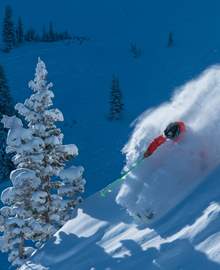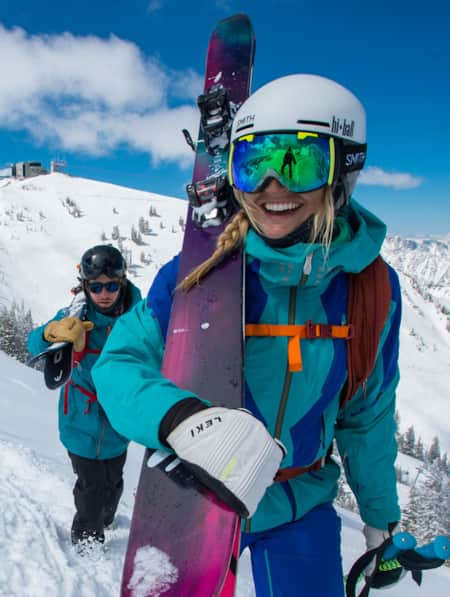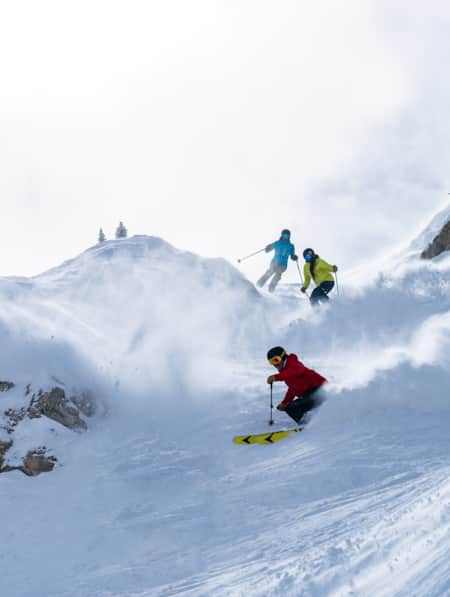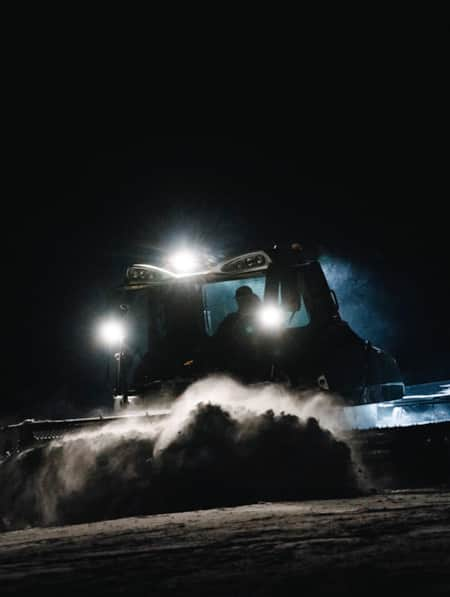Big Snow. Gotta Go.
Here’s what hundreds of inches of dry powder feel like, and how anyone can ski or ride it.

Every winter, magazines and social media show skiers slicing through billowy, chest-deep snow. They’re probably in Utah, where favorable terrain and easy access to over a dozen resorts make it possible for locals and guests to find their own powder paradise regardless of time or budget. Even better, you don’t have to be an expert to enjoy The Greatest Snow on Earth®. Just go! Here’s how...
Shake it! Now, put it down. That’s what skiing a powder day in Utah looks and feels like. It’s akin to being inside a life-size snow globe, one which dampens sound, alters perception and, for a few loose turns, seems to slow velocity and time. Absent is the electrical jolt felt racing down a hard-packed mountainside. It is replaced by an oleaginous flow of glitter. It is magical and mighty gliding through a foot of freshly frozen crystals. What might be the most surprising and exciting for visitors is that because powder skiing is about meteorological peculiarity and not pitch, novices and experts can ski a big powder day in The Greatest Snow on Earth®, if they know where to find it.
"Every skier and snowboarder eventually becomes a powderhound in Utah!"

Solitude Mountain Resort

Snowbird Ski Resort
Powder skiing is ubiquitous to Utah. The arid plains of the Great Basin suck the moisture out of the storms before they hit the western edge of the Wasatch Mountains that bisect the northern half of the Beehive State. This results in preternaturally dry snow. In 2019, with the exception of a single seven-day stretch, the snow continuously fell to near-record levels over a ski season that stretched from November to May (or July 4th at Snowbird, which measured a not record breaking 700+” year-end total).
Although some years are less prolific, only locals are known to complain. Other regions see powder days (the definition of which varies, but roughly more than 8 inches of snow dumped in one period) but, in Utah, where resorts are plentiful and easily accessible, we just seem to see more of them. Every skier and snowboarder eventually becomes a powderhound in Utah!
This can be a divine blessing and a logistical curse. As you watch our current weather conditions, note that if a snowstorm hits on a Friday night, then traffic to resorts (I’m looking at you Cottonwood Canyons — which is to say Brighton, Solitude, Alta and Snowbird) can snake up the two-lane canyon roads the following morning. Go early or just wait until mid-morning to head up.
Pro Tip: These same resorts typically wait to open avalanche-prone areas of the resorts, i.e, the best powder stashes, until later that day or the next. So sleep in and have a big breakfast so you have the energy to ski one, two or three FEET of fresh snow for the rest of the day.
Skiing deep, ungroomed snow is very different than skiing corduroy — not that there’s anything wrong with corduroy. Locals, however, will confess that following animal tracks stamped in a foot of powder through the trees off Empire Bowl in Deer Valley or diving into Mineral Basin at Snowbird or taking a snowcat to the edges of Powder Mountain on a sunny powder day are some of the best experiences on Planet Earth. I just broke the first rule of Powder Club. Don’t worry, in Utah, everyone knows there’s plenty of “pow,” and it’s good karma to “share the stoke.” On groomers, someone else has mapped the trail down the mountain. In untracked powder, you are cutting your own path. A sense of direction and strong legs and core definitely help, but a sense of wonder or a desire to wander, perhaps, is all that’s truly required.
"In untracked powder, you are cutting your own path. A sense of direction and strong legs and core definitely help, but a sense of wonder or a desire to wander, perhaps, is all that’s truly required."
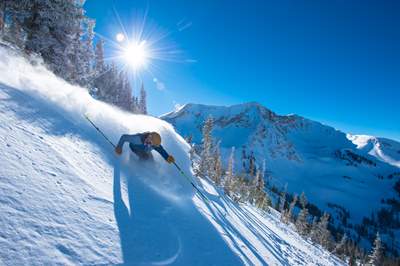

Alta Ski Area
Photo: Scott Markewitz
Skiing and snowboarding in powder is all about flow. Keep moving downhill with as few turns as possible. This is conversely the main barrier to big snow newbies. The voice inside the snow globe warns, “Free-falling downhill is scary; turning can control speed; must turn.”
Yes, as someone who grew up in the South and only learned to parallel ski in her mid-40s, I’ve listened to my own personal "Truman Show” on many runs.
Tight turns work on groomers, but in powder, you’ll sink or … Quick, start the video… you’ll tip over like a grapefruit in a flour bowl — Poof! Powder everywhere! Although Utah powder is lighter than Cascade Concrete allowing you to cut through it like that overturned bowl of flour, you are still moving through sometimes a foot or two or more of it which naturally slows you down. Without the benefit of poles, snowboarders especially need to avoid stopping in deep snow. Utah ski instructors can show you how to make big, long turns down a powder run. Heck, they’ll even help you post your pics online to brag to your kids or grandkids.
If you regularly ski groomers or occasionally ski off-piste or, like me, didn’t know for years what off-piste even meant, then consider taking a half-day powder lesson. You will just save a lot of time and energy. Powder skiing is not about transitioning from pizza to parallel, carving or even skiing the steeps. It’s more about balance, big turns and bounce. Improving these skills in powder, surprisingly, made me a better skier on groomers. So, make the most of your big snow experience, or just learn something new. I haven’t forgotten the saving time and energy part: Lessons go to the front of the line on a busy powder day (time), and instructors know where all the secret powder stashes are kept (energy).
Also, consider renting a pair of “all-mountain” skis for the day. They are wider under your boot (about 88-105mm) than typical groomer skis and will help you “float” on the powder better. Because they have more contact with the snow, many think they feel more stable on groomers, as well, making them the preferred everyday skis for many locals. These are different from “powder skis”, which are even wider (often over 105mm) and depending on experience may be too unwieldy. Discuss which skis are best based on your ability with your rental shop or instructor.
Shake, shake it hard. Nature tries to throw its worst at us here in Utah and, like children, we squeal with joy watching it come down and then play with abandon. We can’t request or predict powder days making each one feel serendipitous and special. We never know where the glitter will land. Skiing big snow is, indeed, different and wonderful and calling out to you to try it this winter.

Planning Your Big Snow Trip
Let’s plan a powder ski trip to Utah and even help you save some time and money while you’re there. Just answer these three questions: Who? When? How much?
